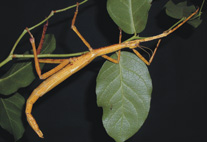Abstract
The tribe Phasmatini Gray, 1835 predominantly includes very striking stick insects of remarkable size, most of which are characteristic for their large and often colourful wings. The tribe represents roughly half of the Giant Stick Insects of Wallacea, a subregion in Eastern Indonesia comprising thousands of islands that are separated by deep water straits from the continental islands to the west (Sundaland: Borneo, Java and Sumatra) and East (New Guinea). Within Wallacea the Phasmatini are represented by four genera, namely Anchiale Stål, 1875, Eurycnema Audinet-Serville, 1838, Paracyphocrania Redtenbacher, 1908 and Phasma Lichtenstein, 1796. Currently eight distinct species are known to occur in the Wallacea. Two of these are newly described in the present paper , this is Anchiale buruense sp. n. and Paracyphocrania major sp. n..
Keys are provided for the distinction of the Phasmatini taxa of Wallacea and information on the overall distribution of the four genera is presented, which reveals a derivation of the tribe from the Australian region. The tribe Phasmatini itself is briefly characterized and discussed. Brief characterizations of the four genera are provided along with complete lists of the species currently contained.
Anchiale Stål, 1875 is represented in the Wallacea by two species. A. maculata (Olivier, 1792) is widely distributed throughout Wallacea except for Sulawesi and shows considerable intraspecific variability. Both sexes and the eggs are illustrated and the eggs formally described for the first time. The synonymies of A. maculata are clarified. A. stolli Sharp, 1898 and A. confusa Sharp, 1898 from New Britain and the Solomon Islands are shown to be errorneous synonyms of A. maculata and are here re-established as valid species (stat. rev.). A. caesarea Redtenbacher, 1908 is removed from the genus Acrophylla Gray, 1835 and transferred to Anchiale (comb. n.). The new species A. buruense sp. n. from the island of Buru (Maluku Islands) is described and illustrated based on both sexes and the egg.
Eurycnema Audinet-Serville, 1838 has two species within the boundaries of Wallacea. E. nigrospinosa Redtenbacher, 1908 is only known from the Kei Islands in the southeastern portion of Wallacea and otherwise found on New Guinea. Both sexes and the eggs are illustrated. E. versirubra Audinet-Serville, 1838 is found on some of the Lesser Sunda Islands and otherwise distributed throughout Java, Sumatra and SE-Borneo. The records from Java, Sumatra and southeast Borneo are estimated to be artificial. Females of this species are dimorph and occur in two distinct colour morphs, which differ by the distinct colouration of the undersides of the tegmina and alae. E. versirubra colour morph versirubra has two forms, the insects either being bright green or dull yellow with the ventral surfaces of the tegmina and alae bright red. E. versirubra colour morph versifasciata, has the ventral surfaces of the tegmina and alae yellow, the insects themselves being pale bluish green to turquoise in colour. Only the bright green form appears to be natural with the other colour-forms caused by parthenogenetic reproduction in captivity. Both sexes, the eggs and the two aforementioned colour-morphs are illustrated.
Paracyphocrania Redtenbacher, 1908 contains two known species and is endemic to Sulawesi and the nearby island of Peleng. The new species Paracyphocrania major sp. n. from Peleng is described and illustrated based on the female and egg. The male remains as yet unknown. The previously unknown male of P. lativentris Redtenbacher, 1908 is described for the first time. Both sexes and the eggs are illustrated. Vasilissa tecticollis Redtenbacher, 1908 is shown to have been misinterpreted previously, here removed from Paracyphocrania and shown to be a synonym of the Australian Tropidoderus rhodomus McCoy, 1882 (syn. n.). Hence, the type-locality of V. tecticollis originally given as “Philippines” is definitely wrong, which proves the tribe Phasmatini is not represented in the Philippines at all.
Phasma Lichtenstein, 1796 is represented in Wallacea with two distinct species and has one further species on New Guinea. A key is provided to distinguish between the three known species of Phasma. Ph. gigas (Linnaeus, 1758) is widely distributed throughout Wallacea and found on almost all major islands, although the historic records from Sulawesi deserve evaluation. Ph. gigas is most certainly not present on New Guinea, with all New Guinean records actually referring to Ph. reinwardtii (de Haan, 1842). Ph. gigas exhibits remarkable intraspecific variability in the colouration and certain morphological features of the insects, with several of these variations appearing to be peculiar to certain localities and islands. The range of variation as well as both sexes and the eggs are illustrated. Papuanoidea straleni Werner, 1930 from New Guinea has erroneously been synonymised with Ph. gigas and is here shown to be a synonym of Ph. reinwardtii (de Haan, 1842) (syn. n.). The second Wallacean representative of the genus, Ph. marosense Hennemann, 1998, is endemic to Sulawesi. The previously unknown male is described for the first time and both sexes and the eggs are illustrated.
Holotypes of the two newly described species, Anchiale buruense sp. n. and Paracyphocrania major sp. n., are deposited in the State Zoological Collections Munich, Germany (ZSMC).

